
Hampton Court astronomical clock is a sixteenth-century astronomical clock in Hampton Court Palace in England.

Hampton Court astronomical clock is a sixteenth-century astronomical clock in Hampton Court Palace in England.
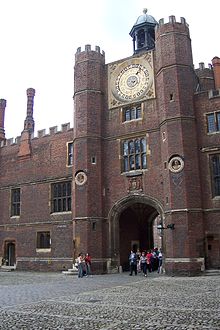
The clock was installed in 1540 on the gatehouse to the inner court at Hampton Court Palace. It was designed by Nicholas Crazter and made by Nicholas Oursian. [1] This pre-Copernican and pre-Galilean astronomical clock is still functioning.
The clock is 15 feet (4.6 m) in diameter with three separate copper dials revolving at different speeds and displays the following information:
The latter information was of great importance to those visiting this Thames-side palace from London, as the preferred method of transport at the time was by barge. Two consequences flowed: journey time, which departing around high water would speed instead of hinder; and all but the most skilled or reckless watermen above the bridge would avoid nearing London Bridge at times of great surface-water ebb under the (then famously built-up, barrage-like) bridge to avoid being swept into the starlings (cutwaters) or arches above.
The clock was restored in 1711 by William Herbert, [3] with a simplified 18th century face, while retaining the 24-hour dial, and a single clock hand. [4] The astrological dials were removed, and subsequently mislaid. In 1831 the mechanism was replaced with that of a 1799 clock from St James's Palace. In 1879 the astronomical dials were rediscovered and replaced, and Gillett & Bland manufactured a new clock movement.
The clock was fully restored in 2007 and 2008 by the Cumbria Clock Company in Dacre, Cumbria in time for the 500th anniversary of the accession of King Henry VIII. [5] [6]
The clock features both on the cover and in the plot of Robert Galbraith’s Troubled Blood . [7]
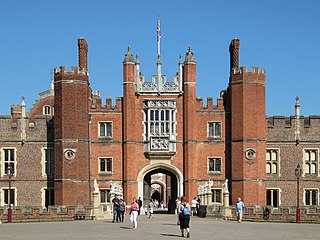
Hampton Court Palace is a Grade I listed royal palace in the London Borough of Richmond upon Thames, 12 miles southwest and upstream of central London on the River Thames.

Hampton is a suburban area on the north bank of the River Thames, in the London Borough of Richmond upon Thames, England, and historically in the County of Middlesex. which includes Hampton Court Palace. Hampton is served by three railway stations, including one immediately south of Hampton Court Bridge in East Molesey.

Bushy Park in the London Borough of Richmond upon Thames is the second largest of London's Royal Parks, at 445 hectares in area, after Richmond Park. The park, most of which is open to the public, is immediately north of Hampton Court Palace and Hampton Court Park and is a few minutes' walk from the west side of Kingston Bridge. It is surrounded by Teddington, Hampton, Hampton Hill and Hampton Wick and is mainly within the post towns of Hampton and Teddington, those of East Molesey and Kingston upon Thames taking the remainder.

The Prague astronomical clock or Prague Orloj is a medieval astronomical clock attached to the Old Town Hall in Prague, the capital of the Czech Republic.
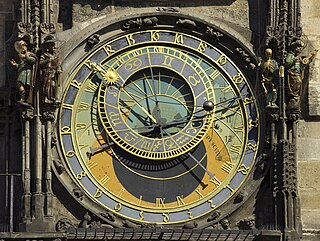
An astronomical clock, horologium, or orloj is a clock with special mechanisms and dials to display astronomical information, such as the relative positions of the Sun, Moon, zodiacal constellations, and sometimes major planets.

Hampton Court Park, also known as Home Park, is a walled royal park managed by the Historic Royal Palaces. The park lies between the gardens of Hampton Court Palace and Kingston upon Thames and Surbiton in south west London, England, mostly within the post town of East Molesey, but with its eastern extremity within the post town of Kingston. In 2014, part of the park was designated a biological Site of Special Scientific Interest. It takes up most of the final (lowest) meander of the non-tidal reaches of the River Thames and is mainly divided between a golf course, meadows interspersed with trees used for deer, seasonal horse grazing and wildlife. A corner of the park is used annually for the Hampton Court Flower Show and the part nearest to the palace has the Long Water — an early set of hydro-engineered ponds or lakes, fed by water from the distant River Colne, as are the bodies of water in the neighbouring park, Bushy Park.

The A308 is a road in England in two parts. The first part runs from Central London to Putney Bridge. The second part runs from just beyond Putney Heath to Bisham, Berkshire. It traces four, roughly straight lines, to stay no more than 3 miles (4.8 km) from the Thames. It is a dual carriageway where it is furthest from that river, in Spelthorne, Surrey and forms one of the motorway spurs to the large town of Maidenhead. Other key settlements served are Fulham, Kingston (London), Staines upon Thames, Windsor and a minor approach to Marlow

The Longford River is an artificial waterway, a distributary designed to embellish a park, that diverts water 12 miles (19 km) from the River Colne at Longford near Colnbrook in England, to Bushy Park and Hampton Court Palace. Its main outlet is to the reach above Molesey Lock with lesser pond outlet channels to that above Teddington Lock. The waterway was built for King Charles I in 1638/39 as a water supply for Hampton Court. Water features in Bushy Park were added in 1710. North of the A30, its course has been diverted more than once as London Heathrow Airport has grown. Its cascades, grassed banks and fountains in Bushy Park were restored and reopened to the public in 2009 to close to their original state.
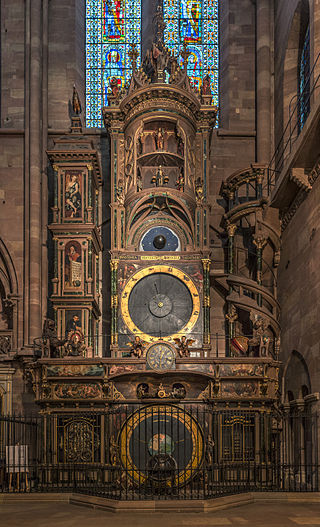
The Strasbourg astronomical clock is located in the Cathédrale Notre-Dame of Strasbourg, Alsace, France. It is the third clock on that spot and dates from the time of the first French possession of the city (1681–1870). The first clock had been built in the 14th century, the second in the 16th century, when Strasbourg was a Free imperial city of the Holy Roman Empire.

Three river islands (aits) form a linear group, close to the junction of the two main old streets of Thames Ditton village, in the River Thames in a corner of modern Surrey, on the Kingston reach above Teddington Lock. Thames Ditton Island, the dominant ait, is 350 yards (320 m) long and has 48 houses with gardens ; Boyle Farm Island has one house; Swan Island, between the two, is the smallest.

St Mark's Clock is housed in the Clock Tower on the Piazza San Marco in Venice, Italy, adjoining the Procuratie Vecchie. The first clock housed in the tower was built and installed by Gian Paolo and Gian Carlo Rainieri, father and son, between 1496 and 1499, and was one of a number of large public astronomical clocks erected throughout Europe during the 14th and 15th centuries. The clock has had an eventful horological history, and been the subject of many restorations, some controversial.
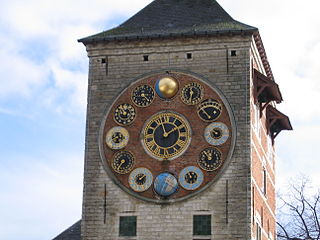
The Zimmer tower is a tower in Lier, Belgium, also known as the Cornelius tower, that was originally a keep of Lier's 14th-century city fortifications. In 1930, astronomer and clockmaker Louis Zimmer (1888–1970) built the Jubilee Clock, which is displayed on the front of the tower, and consists of 12 clocks encircling a central one with 57 dials. These clocks showed time on all continents, phases of the moons, times of tides and many other periodic phenomena.

The A309 is a mostly primary status A-road that runs in two sections, a short section in Twickenham and Teddington as a non-primary status A-road, as well as the much longer primary A- Road section that runs from Hampton Court to Hook.

Astronomical rings, also known as Gemma's rings, are an early astronomical instrument. The instrument consists of three rings, representing the celestial equator, declination, and the meridian.

The Diana Fountain in Bushy Park, in the London Borough of Richmond upon Thames, England, is a seventeenth-century statue ensemble and water feature in an eighteenth-century setting with a surrounding pool and mile long tree lined vistas which honors the Roman Goddess Diana. Originally created for Somerset House in the 1630s, and remodelled about 1690, the fountain has stood since 1713 in Bushy Park, and now forms a large traffic island in Chestnut Avenue.

The Gdańsk astronomical clock is a fifteenth-century astronomical clock in St. Mary's Church, Gdańsk, Poland.
St Albans Riverside is a park in Hampton in the London Borough of Richmond upon Thames. It is linear with long sides between the Thames and Hampton Court Road. It runs from southeast of Garrick's Villa and his Temple to Shakespeare, Garrick's Lawn, Thames Street to a point 90 metres southeast of the interrupting small bridge that serves Tagg's Island.

The Torre dell'Orologio is a 15th-century renaissance tower on the Piazza delle Erbe in Mantua, Italy. It is attached to the Palazzo della Ragione, and next to the Rotonda di San Lorenzo. It houses an astronomical clock.

The Sion astronomical clock is an astronomical clock at the town hall of Sion in the canton of Valais, Switzerland. The clock was first installed in 1667–68; the present mechanism dates from 1902.
The Bourges astronomical clock is an astronomical clock in Bourges Cathedral in Bourges, France.